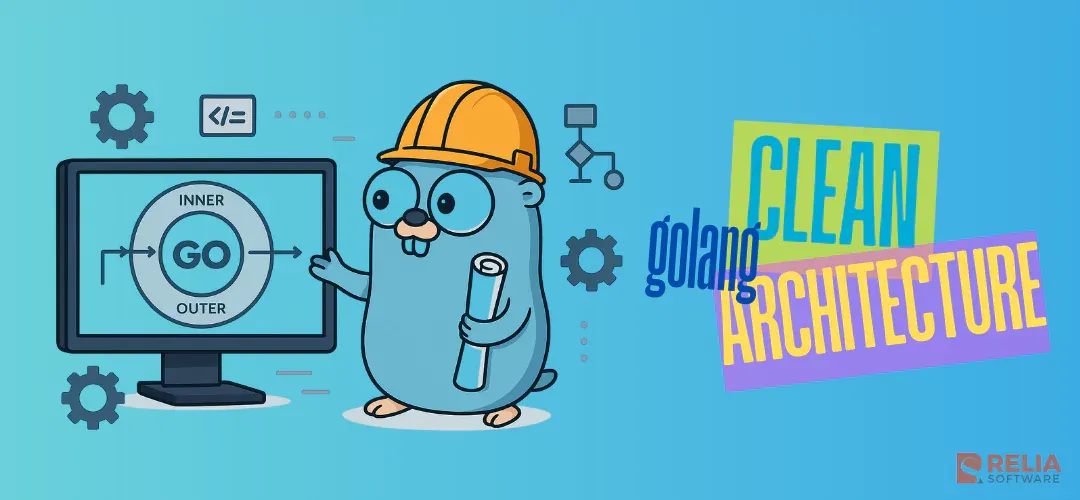In the world of Golang development, Clean Architecture offers a powerful way to structure applications, ensuring that business logic remains independent from external factors like frameworks, user interfaces, and databases. Golang's simplicity and strong typing, combined with its built-in support for interfaces, make it an ideal language to implement Clean Architecture principles.
This article will guide you through implementing Clean Architecture specifically in a Golang application through practical examples, demonstrating how this approach enhances testability and maintainability.
>> Read more:
- Practical Guide to Dependency Injection in Go: Hands-On Implementation
- Golang Error Handling: Advanced Techniques, Tricks, and Tips
- Mastering 6 Golang Concurrency Patterns to Level Up Your Apps
Why Use Clean Architecture in Golang?
Clean Architecture is a powerful approach for building maintainable, scalable systems, and when paired with Golang’s unique features, it offers several compelling advantages:
- Simplicity: Golang’s minimalist syntax makes it easier to implement the clear separation of concerns that Clean Architecture promotes, ensuring maintainable and readable code.
- Interfaces for Flexibility: Golang’s strong typing and interface system allow for flexible, decoupled layers, making it easy to swap out components like databases without affecting core logic.
- Concurrency: Golang's built-in concurrency with goroutines and channels enables scalable performance, with Clean Architecture helping to isolate and manage these tasks effectively.
- Testability: Clean Architecture’s structure, combined with Golang’s lightweight testing framework, enables easy unit testing of isolated business logic, ensuring better test coverage and more reliable code.
- Maintainability: Decoupling layers ensures easier updates, extensions, and refactoring, making Golang applications more maintainable as they grow.
Key Layers of Clean Architecture in Golang
Entities
Entities represent the core business objects and rules. They are the most abstract layer, containing the critical domain logic that remains independent of external frameworks. In Golang, entities are often defined using structs, encapsulating essential data and behaviors that are reusable across different use cases.
Example: A User struct representing the user data and domain-specific behavior, such as validating input or processing changes, without any reliance on external systems.
Use Cases
Use Cases contain the application-specific business logic, orchestrating the flow of data between entities and the outside world. In Golang, they interact with entities to handle operations like CRUD actions or business processes.
The use cases are responsible for implementing what needs to happen in response to user actions, remaining independent of the UI and databases, which makes them easy to test.
Example: A UserService that handles user registration or authentication by interacting with entities and repositories.
Interface Adapters
Interface Adapters act as intermediaries between use cases and external systems, converting data into formats needed by external interfaces like databases or APIs. In Golang, this layer often includes repositories (for data access) and controllers (for HTTP handling). This layer decouples the core logic from external services and technologies.
Example: A repository interface that abstracts the database logic, ensuring that the database can be swapped out without modifying the business logic.
Frameworks and Drivers
Frameworks and Drivers include the external dependencies such as web frameworks (like GIN-GONIC) and databases (such as GORM). This layer is where input/output operations take place, such as handling HTTP requests or interacting with a database, but it is kept separate from the core business logic to maintain flexibility.
Example: A handler that uses GIN to parse incoming requests and forwards them to the use cases for processing.
Project Structure for Clean Architecture in Golang
A clear project structure is crucial for code maintainability and scalability. By following Clean Architecture, each layer of the application is separated with clear responsibilities, reducing dependencies and making testing and modification easier.
Below is an example of a Clean Architecture Project Structure in Golang:
/project
├── /cmd
│ └── /app
│ └── main.go
├── /pkg
│ ├── /entities
│ │ └── user.go
│ ├── /usecases
│ │ └── user_usecase.go
│ ├── /adapters
│ │ ├── /controllers
│ │ │ └── user_controller.go
│ │ ├── /repositories
│ │ │ └── user_repository.go
│ │ └── /presenters
│ │ └── user_presenter.go
│ ├── /frameworks
│ │ ├── /db
│ │ │ └── db.go
│ │ └── /web
│ │ └── server.go
├── /configs
│ └── config.yaml
├── /internal
│ ├── /middleware
│ │ └── auth_middleware.go
│ └── /utils
│ └── logger.go
└──Breakdown of the Structure
- /cmd/app: This directory contains the entry point of the application. The
main.gofile initializes and starts the application, setting up necessary configurations and dependencies. - /pkg: This is the main directory containing the core layers of the application.
- /entities: Contains the core business objects and rules. For example,
user.godefines theUserentity. - /usecases: Contains application-specific business logic. For example,
user_usecase.godefines the use cases related to user operations. - /adapters: Contains the interface adapters that bridge the core logic with external systems.
- /controllers: Handles incoming HTTP requests and invokes the appropriate use cases. For example,
user_controller.go. - /repositories: Handles data persistence. For example,
user_repository.gointeracts with the database. - /presenters: Formats the output for the client. For example,
user_presenter.go.
- /controllers: Handles incoming HTTP requests and invokes the appropriate use cases. For example,
- /frameworks: Contains external tools and technologies.
- /db: Database configuration and connection management. For example,
db.go. - /web: Web server setup and routing. For example,
server.go.
- /db: Database configuration and connection management. For example,
- /entities: Contains the core business objects and rules. For example,
- /configs: Contains configuration files. For example,
config.yamlincludes application configurations such as database connection strings, API keys, etc. - /internal: Contains internal packages that are not meant to be used by external applications.
- /middleware: Contains middleware functions for handling cross-cutting concerns. For example,
auth_middleware.go. - /utils: Contains utility functions. For example,
logger.gofor logging in Go.
- /middleware: Contains middleware functions for handling cross-cutting concerns. For example,
This structure helps enforce separation of concerns, making your Golang projects easier to maintain and scale.
Implementing Clean Architecture in Golang with Code Examples
This section focuses on the practical implementation of Clean Architecture layers in Golang and explores how they interact.
- Entities Layer: Entities define the core business objects using structs in Golang. Example (User entity):
// entities/user.go
package entities
type User struct {
ID int
Name string
Email string
Password string
}
- Use Cases Layer: Use cases manage the business logic and operations, interacting with entities and repositories. Example (UserInteractor):
// usecases/user_usecase.go
package usecases
import "example.com/project/entities"
type UserRepository interface {
CreateUser(user *entities.User) error
GetUserByID(id int) (*entities.User, error)
}
type UserInteractor struct {
UserRepository UserRepository
}
func (uc *UserInteractor) RegisterUser(name, email, password string) error {
user := &entities.User{
Name: name,
Email: email,
Password: password,
}
return uc.UserRepository.CreateUser(user)
}- Interface Adapters Layer: Interface adapters bridge the core business logic with external systems like web services or databases. Example (UserController):
// adapters/controllers/user_controller.go
package controllers
import (
"encoding/json"
"net/http"
"example.com/project/usecases"
)
type UserController struct {
UserInteractor usecases.UserInteractor
}
func (uc *UserController) RegisterUser(w http.ResponseWriter, r *http.Request) {
var req struct {
Name string `json:"name"`
Email string `json:"email"`
Password string `json:"password"`
}
if err := json.NewDecoder(r.Body).Decode(&req); err != nil {
http.Error(w, err.Error(), http.StatusBadRequest)
return
}
err := uc.UserInteractor.RegisterUser(req.Name, req.Email, req.Password)
if err != nil {
http.Error(w, err.Error(), http.StatusInternalServerError)
return
}
w.WriteHeader(http.StatusCreated)
}- Frameworks and Drivers Layer: This layer deals with external dependencies such as databases and web frameworks. Example (UserRepository):
// adapters/repositories/user_repository.go
package repositories
import (
"database/sql"
"example.com/project/entities"
)
type UserRepository struct {
DB *sql.DB
}
func (repo *UserRepository) CreateUser(user *entities.User) error {
_, err := repo.DB.Exec("INSERT INTO users (name, email, password) VALUES (?, ?, ?)", user.Name, user.Email, user.Password)
return err
}
func (repo *UserRepository) GetUserByID(id int) (*entities.User, error) {
row := repo.DB.QueryRow("SELECT id, name, email, password FROM users WHERE id = ?", id)
user := &entities.User{}
err := row.Scan(&user.ID, &user.Name, &user.Email, &user.Password)
return user, err
}- Wiring Everything Together: The
main.gofile connects all layers and starts the web server. Example (main.go):
// cmd/app/main.go
package main
import (
"database/sql"
"log"
"net/http"
"example.com/project/adapters/controllers"
"example.com/project/adapters/repositories"
"example.com/project/usecases"
_ "github.com/go-sql-driver/mysql"
)
func main() {
db, err := sql.Open("mysql", "user:password@/dbname")
if err != nil {
log.Fatal(err)
}
userRepo := &repositories.UserRepository{DB: db}
userInteractor := usecases.UserInteractor{UserRepository: userRepo}
userController := controllers.UserController{UserInteractor: userInteractor}
http.HandleFunc("/register", userController.RegisterUser)
log.Println("Server started at :8080")
log.Fatal(http.ListenAndServe(":8080", nil))
}Comparison of Clean Architecture with Other Architectures in Golang
| Principle | Clean Architecture | Hexagonal Architecture | Onion Architecture |
|---|---|---|---|
| Core Idea | Separation of concerns into layers | Ports and Adapters pattern | Layers around the domain model |
| Independence from Frameworks | High | High | High |
| Testability | High | High | High |
| Independence of UI | High | High | High |
| Independence of Database | High | High | High |
| Independence of External Agencies | High | High | High |
| Layered Organization | Entities, Use Cases, Interface Adapters, Frameworks & Drivers | Domain, Ports, Adapters | Core, Domain, Services, Infrastructure |
All three architectures aim to create a robust and adaptable system by enforcing the separation of concerns. Each method promotes loose coupling between components and allows the core business logic to remain independent from external systems, ensuring flexibility and easier maintainability.
In a Golang context, the choice between these architectures can depend on the complexity of the project:
- Clean Architecture might be preferred in microservices or REST APIs due to its strict separation of concerns and testability, which can handle frequent changes in external services.
- Hexagonal Architecture might suit projects requiring a high level of adaptability with external interfaces, such as third-party APIs or event-driven systems.
- Onion Architecture is ideal for domain-centric applications, where the integrity of business logic is paramount and must remain insulated from external infrastructure changes.
>> Read more about SOLID principles:
- Practical SOLID in Golang: Single Responsibility Principle
- Mastering the Open/Closed Principle in Golang
- Mastering the Liskov Substitution Principle in Golang
- Mastering The Interface Segregation Principle in Golang
- Best Practices For Dependency Inversion in Golang
- Detailed Code Examples of Dependency Inversion Principle in Go
Conclusion
In this article, we explored the practical implementation of Clean Architecture in Golang, demonstrating how its principles ensure maintainable, scalable, and testable systems. We explored each layer—Entities, Use Cases, Interface Adapters, and Frameworks & Drivers—highlighting their roles in structuring a Go application.
Through practical examples, we illustrated how these layers interact to keep the codebase flexible and resilient to changes.
By using Clean Architecture, developers can maintain clear separation between business logic and external dependencies, resulting in a well-organized and adaptable Go application that can evolve with technological changes without significant rework.
>>> Follow and Contact Relia Software for more information!
- golang
- coding
- Web application Development

